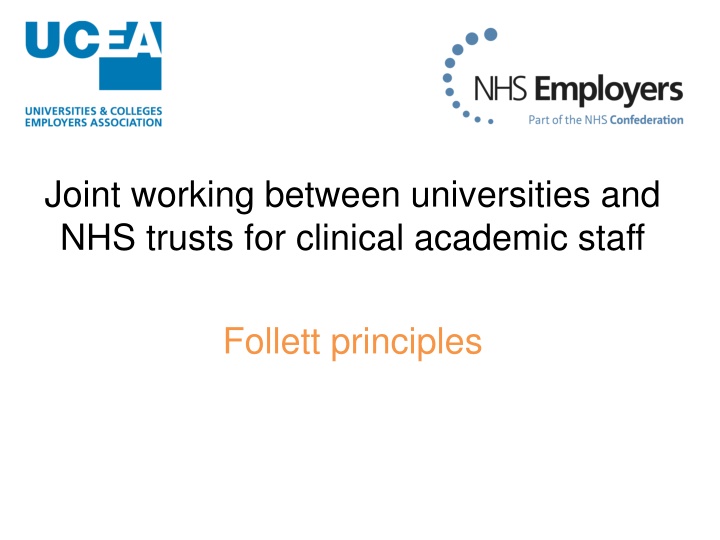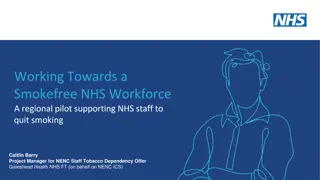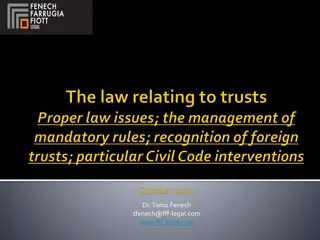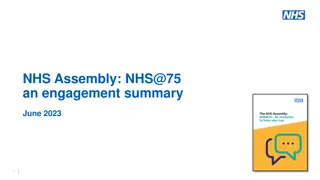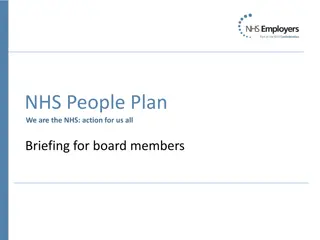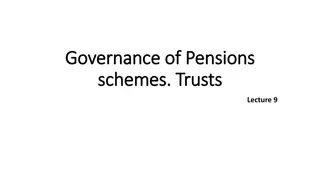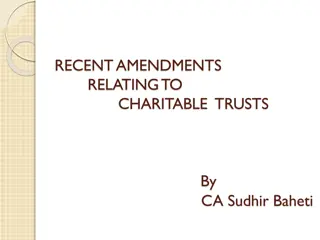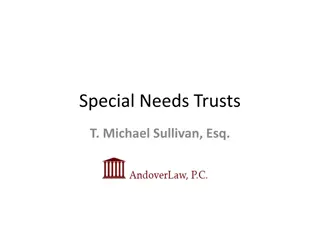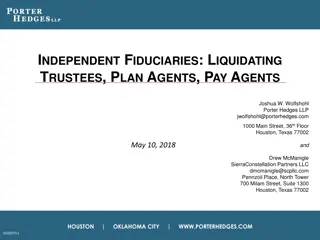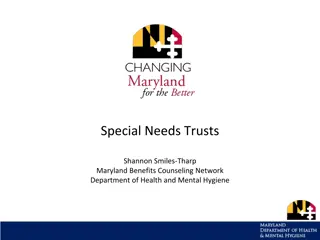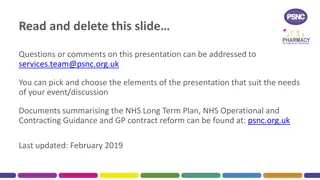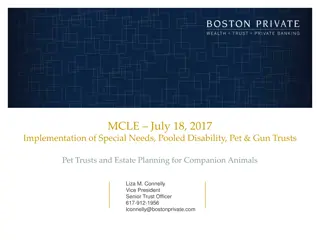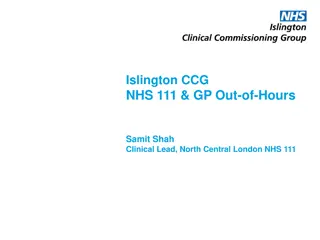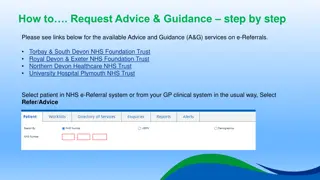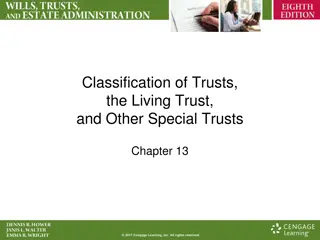Enhancing Clinical Academic Collaboration Between Universities and NHS Trusts
Clinical academics play a crucial role in integrating clinical practice, research, and education within the NHS. Collaboration between universities and NHS trusts is key to ensure clinical academics address the right questions for patient care and societal benefit. Challenges include an aging clinical academic workforce and decreasing numbers. Joint working models, shared oversight, and robust contracts are essential for the success of clinical academics in the healthcare system.
Download Presentation

Please find below an Image/Link to download the presentation.
The content on the website is provided AS IS for your information and personal use only. It may not be sold, licensed, or shared on other websites without obtaining consent from the author.If you encounter any issues during the download, it is possible that the publisher has removed the file from their server.
You are allowed to download the files provided on this website for personal or commercial use, subject to the condition that they are used lawfully. All files are the property of their respective owners.
The content on the website is provided AS IS for your information and personal use only. It may not be sold, licensed, or shared on other websites without obtaining consent from the author.
E N D
Presentation Transcript
Joint working between universities and NHS trusts for clinical academic staff Follett principles
Clinical academics One job all for the benefit of the NHS One job with integrated responsibilities: clinical practice in the NHS conduct research to the benefit of the NHS teaching leading education for NHS staff: medical, dental, nursing, midwifery, allied health provide quality assurance for teaching in the NHS.
Clinical academics Research: improves clinical practice boosts the economy delivers benefits to society improves healthcare internationally. Joint working with the NHS can ensure that clinical academics are answering the right questions for the NHS, and for patients.
Clinical academics Qualified doctor or dentist (including those in specialist training). Hold a substantive academic contract of employment with an higher education institution (HEI) and honorary contract with an NHS body/bodies (can be the other way around). Required, as a condition of their employment, to hold General Medical or Dental Council (GMC/ GDC) registration and, where relevant, a licence to practise.
Clinical academics 3,094 full time equivalent (FTE) clinical academics in the UK circa 5 per cent of the medical consultant workforce. Decreasing numbers; whilst NHS consultant numbers increase.
Clinical academics An aging section of the workforce: over 35 per cent of clinical academics are aged 56-65 5 per cent are over 65 the numbers aged under 45 have declined. We need to make it easier to pursue a clinical academic career!
Joint working: HE and NHS Shared oversight / Joint working NHS Trust HEI Honorary Employment Contract Substantive Employment Contract Clinical Academic
Drs & Dentists Review Body (DDRB) General Medical Council General Dental Council Royal Colleges Dept Health & Social Care Trades Union NHS England BEIS / Dept. for Education Scottish Government Higher Education Institution NHS Skills for Care Patients CA Students Higher Ed. Funding Councils (England & Wales) Public Health England Welsh Government Funders University & Colleges Employers Assoc (UCEA) Medical & Dental Schools Councils NHS Employers
Follett report Joint oversight Joint working
Follett report 1999 Alder Hey organ retention scandal 1999 Public enquiry began January 2001 Redfern report published: Serious concerns raised about the management and accountability of clinical academic staff September 2001 Follett review of appraisal, disciplinary and reporting arrangements for joint appointments between the NHS and universities
Follett report Joint working to integrate separate responsibilities Linked substantive and honorary contracts (total interdependency of the contracts was ruled out on legal advice). Joint strategic planning bodies (much harder when there is more than one trust). Clear, distinct lines of accountability, jointly set out. All staff to be aware of who they are accountable to.
Follett principles Joint working: joint recruitment and appointment jointly agreed induction joint job planning joint appraisal agreed processes for management of performance and conduct.
Joint recruitment Joint NHS and university procedures for the appointment of senior staff with academic and clinical duties. Agreed with Department of Health in 2004. Designed to help higher education institutions (HEIs) and the NHS implement the Follett recommendations. (England & Wales. Separate guidance for N Ireland) To be read in conjunction with the NHS Appointment of Consultants Regulations Good Practice Guidance.
Joint job planning Integrated job plan Split of activities: NHS and academic programmed activities (PAs) Changes to PAs must be a joint decision between the trust(s), higher education institute (HEI) and individual Supporting professional activities (SPAs) Accountability arrangements Agree support and facilities - NHS & higher education institution (HEI)
Joint appraisal Must be a joint appraisal (Follett): Two appraisers (one from the NHS, one from higher education) Working with the appraisee in a single meeting Recommended that appraisal training is done jointly See University and Colleges Association (UCEA) Guidance on clinical academic staff appraisal.
Conduct In a disciplinary situation: either the substantive employer s or honorary employer s procedures may be used, depending on the situation. Department for Health and Social Care (DHSC) guidance on Maintaining High Professional Standards in the NHS: Appendix with guidance on clinical academic staff, including an outline protocol between a higher education institution (HEI) and a trust. Dismissal can only be undertaken by the substantive employer, although an honorary contract can be terminated.
HEI and trust responsibilities Separate contracts Each body has separate responsibility for its duties as an employer. Exchange of personal data should only occur in line with GDPR (EU General Data Protection Regulations). But interlinked Memorandum of Understanding (MoU) between the parties. Strong strategic relationship. Interdependency clause in contracts. Clear protocols. Maintaining meaningful dialogue. Key contacts.
MoU between the HEI & NHS Trust Purpose is fourfold: 1. To set out the NHS and HEI understanding of the role of joint staff engaged in both teaching and/or research as well as the delivery of patient care. 2. To clarify the duties and responsibilities of the employers. 3. To document established practice. 4. To confirm that such arrangements are outside the scope of VAT.
MoU between the HEI & NHS Trust Scope: job planning and appraisals separate contracts of employment with each employer discharging their own duties and responsibilities remuneration employee relations joint working
HEI & NHS Trust relationship Importance of relationship-building at all levels. Refresh when there is staff turnover. The Medical Director and Dean may understand the relationship and benefits but do others in operations, HR, finance, contracts?
Moving between sectors Clinical academic trainees have to move between the NHS and higher education: To achieve Certificate of Completed Training (CCT) To complete a higher degree / research. Seamless transition Complexity, no recognition of service, time in HE viewed as out of programme Goal Reality
Follett: Just for consultants? Expectation that the principles should extend to all joint appointments with both clinical and academic responsibilities e.g.: Doctors in training Nurses Midwives Allied health professionals Research fellows Healthcare scientists Public health trainees GPs
Follett principles in practice Revalidation has helped develop a more seamless process of appraisal and development. Clinical Excellence Awards processes take into account all work activity, including research, innovation and education.
Follett principles in practice But just following these processes is not sufficient: Communication between the employers remains the biggest challenge. Extension beyond consultants requires even closer communication and cooperation. Other processes and arrangements will be relevant e.g. national appraisal frameworks, ARCP requirements, work schedule review processes, role of Deanery.
What if Follett isnt followed? Lack of integration: effectively 2 part-time jobs. Imbalance between the parts of the role. Playing off one employer against another, e.g. in job planning, appraisal or disciplinary. Another Alder Hey scandal : potentially significant clinical and reputational risks. Lack of clarity over employer responsibilities, e.g. who carries out Occupational Health (OH) and Disclosure and Barring Service (DBS) checks. Lack of transparency over concerns. Lack of awareness of changes to the role. Funding disputes. Tax implications: VAT MoU.
VAT MoU Memorandum of Understanding (MoU): Joint staff of Universities and NHS organisations i.e. with substantive and honorary higher education and NHS contracts. One job not supplying services from one organisation to another. Arrangements that comply with the MoU are outside the scope of VAT.
VAT MoU Honorary and substantive contracts Employer duties and responsibilities Integrated job plan Recruitment Employeeduties and responsibilities Disciplinary procedures Protocol for joint working Remuneration Job planning Appraisal Personal data Interdependency
Follett checklist Framework for strategic liaison at senior level. MoU between the NHS body and the higher education institution (HEI). Jointly agreed recruitment process. Jointly prepared job description. Evidence of jointly agreed induction & interview process. Jointly agreed contracts/documents specifying accountabilities. Managers fully aware of responsibilities re integrated job plan. Joint appraisal process. Named appraisers from the HEI and NHS body. Jointly agreed personal development plan. Agreed procedures on joint working for disciplinary / performance / conduct issues.
Future The future is collaborative. Strategic partnerships are key. Need to spread understanding of joint working beyond senior managers. Higher education and NHS institutions will be challenged by increasing demand and cost pressures: innovation requires investment in time and talent align clinical practice, education and research ambition. NHS long-term plan and People plan: critical importance of research and innovation to drive future medical advances patients benefit enormously from research and innovation.
